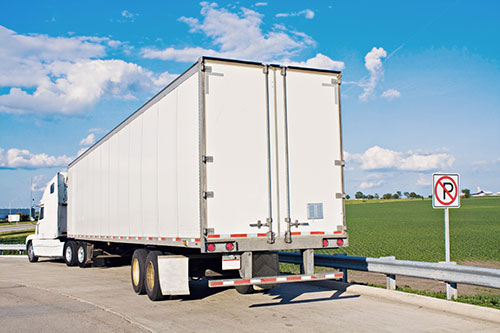
Parking along an interstate entrance/exit ramp is not always safe or legal. Dispatchers can help drivers plan their routes so they can identify safe and legal parking options.
This article is from the Summer 2015 issue of The Quill. To view the full issue, visit The Quill archive.
Everyone is intimately familiar with the Hours of Service (HOS) BASIC within the Safety Measurement System. For the majority of transportation companies, this BASIC seems to be one of the more difficult BASICs to get under control. It is a simple problem to alleviate, right? When a driver has exhausted their legal hours, they simply pull into the nearest truck stop or rest area and take a break or wait for their reset.
But what does a driver do when there is no parking available at a truck stop or rest area? Do they continue until they find a place to legally park and risk an HOS violation, or do they simply pull over to the side of the road and risk their safety in order avoid running over on hours? Unfortunately, this is not an easy question to answer.
In 2002, the Federal Highway Administration (FHWA) published a Study of Adequacy of Commercial Truck Parking Facilities report “…which found that existing demand for truck parking spaces outstripped the available supply and that projected increases in vehicle miles of travel by truck would worsen the problem.” In 2012, the FHWA published an updated report that concluded what was discovered in 2002, parking shortages for CMVs is a widespread issue that continues to worsen.
An article in the Wall Street Journal on January 20, 2015, supports the FHWA’s findings that the parking shortage is real, and it is increasingly getting worse. The American Trucking Associations estimates that in 2014 there were 2.3 million Class 8 trucks registered in the U.S. with a gross weight of over 33,000 pounds, and the number is likely to rise with the recent trend in decreasing fuel costs. While the increase in truck traffic is a sign of a recovering economy, it will make a recognized issue even more difficult.
For many, the most viable option is to stop and rest on the side of an interstate entrance/exit ramp. While this is a common practice along most interstate routes, it is not always a legal option for the drivers. This is also a major safety concern, especially at night. Other drivers may attempt to catch up on their rest at the customer’s facility while they wait for their designated appointment, but as most are aware, many companies do not allow trucks on their property until their appointment time.
Jason Rivenburg was one such driver who was delivering to a facility that did not allow trucks on its property until their designated appointment time. On Wednesday, March 4, 2009, Rivenburg parked at an abandoned gas station 12 miles from his designated stop and was robbed and murdered for $7.00. Rivenburg’s tragedy spawned a call to action and the passing of “Jason’s Law” which calls for the construction of safe truck parking facilities, ability to use existing areas such as weigh stations and park-and-ride facilities, and other means to increase safe parking areas for drivers. As everyone is well aware, the full effects of Jason’s Law have yet to be realized.
Until Jason’s Law realizes its full potential, drivers need as much assistance as possible to help combat the parking issues they are facing. There are a myriad of ways to help drivers with this issue.
Dispatchers can help drivers plan their routes so they can identify the safest parking options should they be needed. Awareness to the issue through driver training would also be beneficial to help drivers understand the issues and concerns, and help them make the best and safest decision on where they will park should the need arise. Perhaps the best option for companies currently is to call the truck stops, with which many companies have fuel contracts, and ask them to increase their parking capacity. This alone will give the drivers increased options to safely park their equipment while maintaining compliance with HOS. The drivers should not have to face this issue alone. It is everyone’s responsibility to do their part to ensure our drivers arrive home safe to their families.
As an industry, we need to help drivers with better trip planning. Drivers need to calculate where they are starting from and an approximate distance they can realistically drive for the day. Determine in advance the best locations that are within three hours prior to reaching that destination. This may seem like an extensive amount of time, but planning for delays is part of proper trip planning and will help the driver stay at safe and select locations that are within the hours-of-service requirements.